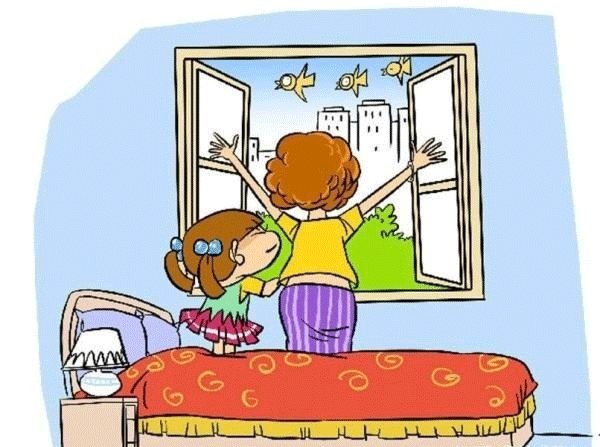The importance of routine moments in the organization of preschool children
The nature of games, the tasks they solve, and their impact on the body are different: didactic games are similar to classes. They, like role-playing games and games with building materials, contribute to the development of the senses, the formation of complex processes of mental activity - speech, logical thinking, imagination, memory, etc. While providing emotional coloring of wakefulness, they do not provide motor release. This task is performed by outdoor games, which help strengthen the body, increase its endurance, improve movement, develop moral qualities, strong-willed character traits, and organization. Outdoor games relieve fatigue after activities associated with static efforts and mental stress, and satisfy children's need for movement.
8. Sleep. During sleep, the child has the opportunity to restore not only his physical strength, but also relax his nervous system and calm down. Daytime naps keep your baby active in the afternoon. With age, children's need for daytime sleep goes away; they are able to do without it. However, it is necessary to properly organize night sleep, namely going to sleep, its duration, the child’s sleeping place, and awakening. When organizing sleep, it is important not only to maintain its duration, but also to ensure that children sleep well. In bedrooms and groups that are temporarily converted into bedrooms, it is important to create conditions for restful sleep: fresh air must constantly flow into the rooms where children sleep, accelerating the onset of sleep and maintaining its physiological depth and duration (temperature 14-15°), comfortable beds , dim light, silence. The teacher must be in the bedroom with the children.
9. Compliance with cultural and hygienic skills
The daily routine ensures daily repetition of hygiene procedures at the same time - this contributes to the gradual formation of cultural and hygienic skills, education, organization and discipline. This happens in games, work, activities, and in everyday life.
10. Work
. The content of child labor is varied. This includes self-service, household work, work in nature, on the site (cleaning playgrounds, clearing the area of snow, shoveling sand in sand boxes), in a mini-garden (loosening and digging beds, planting, watering, weeding plants, collecting harvest, etc.). Rationally organized work activity enriches the motor mode and helps relieve fatigue from activities associated with mental stress. It is more advisable to organize work in nature in the afternoon, from 15:40 to 16:30. These recommendations are based on a number of significant circumstances. In the specified period of time, a good functional state of the child’s body is noted; Since the morning hours are full of academic activities, carrying out work in the second half of the day makes it possible to distribute the load relatively evenly. Finally, with this routine, the first walk is maintained. In the hot season, it is advisable to plan work in a mini-garden in the morning before breakfast, due to the fact that in the afternoon the spectrum of sunlight is dominated by heat rays, and an increase in thermal exposure is undesirable during physical activity. The duration of work on the site in the senior group is limited to 10 minutes, in the school preparatory group - 15 minutes. Household work can take longer - up to 25-30 minutes. The effectiveness of the lesson is determined by the duration of children's active attention. For preschoolers 3-4 years old it does not exceed 10 minutes, 4-5 years old - 15 minutes and 6-7 years old - 25 minutes.
On the topic: methodological developments, presentations and notes
The summary presents one of the options for introducing older preschoolers to “Digestive Gymnastics” (author: A.S. Rudenko), as well as a method of generalization with children of older preschool age.
Tell the children what “soap” is for.
Progress of the regime moment Lunch.
I compiled a summary of hardening back in 2005. Goal: to ensure training of the body’s defenses to the effects of constantly changing environmental factors.
Source
Consultation for parents: “How to prepare a child for sleep in a kindergarten?”
Municipal budgetary preschool educational institution kindergarten "Solnyshko" Smolensky district, Smolensk region
CONSULTATION FOR PARENTS
“How to prepare a child for sleep in a kindergarten?”
Prepared
Teacher of the first qualification category
Timofeeva Lyudmila Petrovna
2021
How many hours does a preschool child need to sleep?
There is no definite answer; it all depends on the individual child - his temperament, state of health and characteristics of the day.
One of the most important factors in the harmonious development of a child is daytime sleep. Research results showed that children aged 3-4 years who were not put to bed during the day showed higher levels of hyperactivity, anxiety and depression than children who continued to sleep 1-2 hours daily at lunchtime. Scientists have come to the conclusion that daytime sleep not only perfectly replaces possible shortcomings of night sleep, but is also important in itself as a respite for the body of an energetic child. A nap is a wonderful opportunity to recuperate and spend the rest of the day in a good mood.
For children of early and preschool age, physiologically adequate sleep is the basis for good health and proper development.

The need for sleep is largely related to environmental conditions with the functional state of the body and depends on many other factors.
The child’s nervous system is not yet sufficiently formed, it does not have great endurance and is subject to relatively rapid exhaustion. Frequent lack of sleep, which is determined not only by insufficient duration of sleep, but also by poor quality of sleep, when it is restless and often interrupted, has a particularly adverse effect on her condition and the condition of the body as a whole.
Long-term lack of sleep is often the cause of neurotic conditions, characterized by the appearance of irritability, tearfulness, and weakening of memory in a child. In some cases, children become excited and pugnacious, in others, on the contrary, lethargic and indifferent to their surroundings. Neurotic conditions can also be accompanied by headaches, decreased appetite, and the body's resistance to diseases, since insufficient sleep negatively affects the state of all physiological systems and functions of the body that are closely related to the regulatory activity of the nervous system.
Children of preschool age should sleep at least 11-12 hours a day. Daytime sleep, depending on age, lasts up to 2-2.5 hours. It is mandatory, since the child’s nervous system quickly reacts to external stimuli, is relatively easily wounded and is less resilient than with the adult nervous system. That is why active continuous wakefulness of preschoolers is limited. If a child in kindergarten does not sleep, then we must find out the reason for this, talk with the parents, doctor or kindergarten nurse.
When creating conditions for a child to sleep well, you should remember that fresh air is the best “sleeping” and healing agent. Therefore, before going to bed, you should ventilate the room for 15-20 minutes.

Clothes for sleeping indoors should be loose, made from soft cotton fabrics. The most convenient for this purpose would be a long shirt or pajamas without pockets with a small number of buttons. During the hot season, children can sleep in only shorts designed specifically for sleeping. It is important to constantly ensure that children do not become hypothermic or overheated during sleep. The position in which a child sleeps significantly affects the quality of sleep. It is better if he falls asleep lying on his right side or on his back. In such body positions, the internal organs experience the least pressure from the body weight.

Going to bed is the most difficult and crucial moment in organizing sleep, which is of great importance for its normal course; It is necessary to kindly and at the same time persistently put the child to bed. This is the only way to quickly fall asleep. When organizing sleep, first of all, weakened children, children who fall asleep quickly, and those who behave calmly before bed are placed first. Children who are excitable and restless when falling asleep are put to bed last, in order to pay more attention to them (sit next to them, stroke them, etc.).
A calm environment will create an overall positive mood before bed, and a quiet bedroom will promote deep sleep. To create a positive attitude towards sleep in children, movements should be calm, soft, speech should be quiet and affectionate. Laying down and raising children is carried out in a calm environment.
You need to set the mood for sleep in advance: “We’ll be sleeping soon. Let's put away the toys. They are also tired and want to rest. Well done, Dashenka, I put the doll to sleep.” and so on.
Restless, prolonged falling asleep of a child directly affects the further course of the entire sleep, making it shallow and anxious. Therefore, it is so important that before bedtime children are in a state of moderate fatigue from previous activities, but are not overtired. The education and training program allocates constant time to sleep during the day, which helps the child develop a stable positive reflex for time and facilitates the process of falling asleep.
The child's daily need for sleep is satisfied mainly through night sleep, which, as a rule, takes place at home. Adults must understand the importance of night sleep and create the necessary conditions for its normal occurrence. We persistently explain to parents that it is necessary to put their children to bed in a timely manner and not to play noisy games that stimulate the nervous system just before bedtime.
Some tips for parents to prepare
babies to bed:
• Avoid noisy outdoor games several hours before bedtime;
• If possible, take a walk with the whole family near the house so that the body receives as much oxygen as possible;
• In the warm season, the window in the bedroom can be left open all night; in winter, it is enough to ventilate the room before going to bed;
• Create a calm, peaceful evening environment;
By following these simple tips, you will not have any difficulty allowing your child to enjoy a healthy, rewarding and enjoyable sleep.






